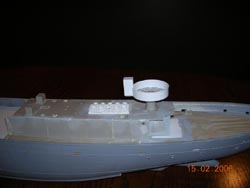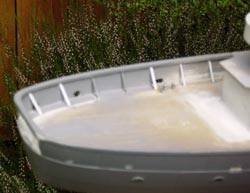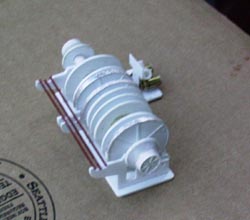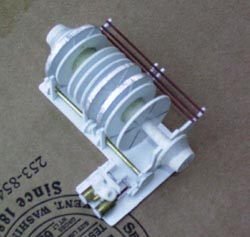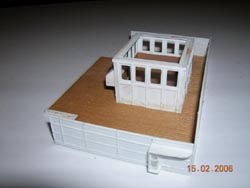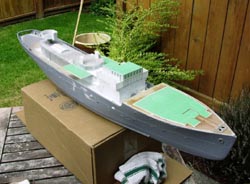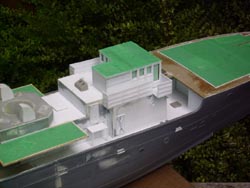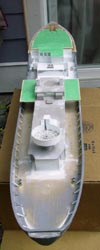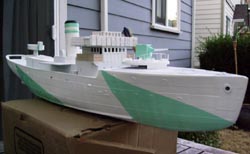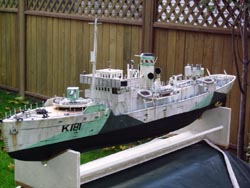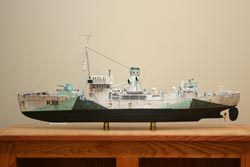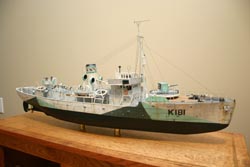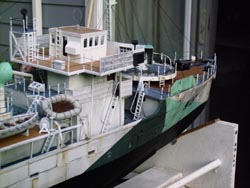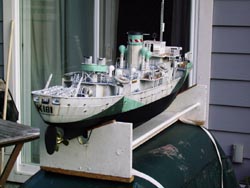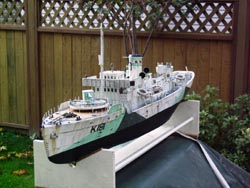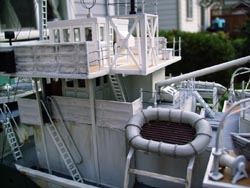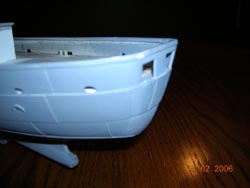1/72 HMCS Sackville
Conversion from the Matchbox Flower Class Corvette
By John Beaulieu
|
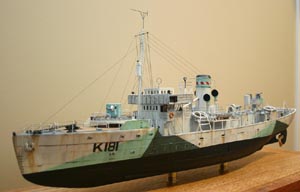 |
Introduction
I was first approached with this project back in early 2005, when Chief
Petty Officer Lake, the divisional chief for CFB Esquimalt's seamanship
school, asked if I would be willing to build a flower class corvette for
the school. He had seen the work I had done on a previous model (HMCS
Regina) and was hoping that I would do something similar on an old Matchbox-issue
corvette he had lying around.
Beware of kits that have been ‘lying around’! Having been
started some fifteen years ago, the boat now required extensive disassembly
and there was a crack running down starboard side across the midship seam.
Due to the long-term storage of the kit, several items were missing and
or damaged. These included the mast, most of the handrails, stanchions,
the bilge keels, most of the secondary armament and stowage cabinets.
With so much of the kit badly assembled, damaged or missing, I decided
to convert it to represent the short fosc’le HMCS Sackville (circa
1942). My first step would be to backdate the hull.
Backdating the hull entailed removing approximately five inches of
deck off of midship and the hull, laying a new deck, building a new superstructure
(house, wheelhouse and bridge), construction of a new deck below the gun
deck and the squaring off of the stern. Also, I had to build a mine sweeping
winch and two steam davits.
A new mast needed to be built to replace the missing kit part. This
was done in brass and included the SW1C antenna. At this time a small
loop antenna was built out of brass for the roof of the chartroom.
The engine room casing needed to be shortened, the rear bandstand was
relocated to aft of the engine room skylight, and the bandstand’s
sidewalls were removed and re-skinned and the ‘spider web’
tread was applied to the floor of the bandstand. A new ammo locker was
built. The engine room skylight was removed and a new, accurate skylight
was built and installed in its place.
The stern of the boat was squared off, the heavy, inaccurate keel was
removed and new bilge keels (Plastruct ‘L’ beams) were attached.
Two 5/16 nuts were glued to the bottom of the hull (mounting hard points.)
Resin blocks were cast around the bolts for security. The portholes were
cleared out, the plastic behind them thinned and mirrors were epoxied
in place. People who walk past the hull will catch flickers of movement
from the portholes, giving the illusion that the ship is manned and ready.
The hull was filled with expanding foam to provide structural integrity.
The new foredeck was installed and the new superstructure was glued
in place. The bridge wings and fosc’le were skinned with wood and
sealed. The bridge wings and wheelhouse catwalk stanchions were built
and had simulated canvas installed. The 4” gun platform had it’s
tread applied. The gun shield’s sidewalls were removed and thinner,
more accurate ones were glued in place. A blast bag was moulded from Miliput
and installed on the gun.
All the ventilators were thinned and access panels were installed on
the large ventilators. The funnel cap, which was heavily damaged, was
repaired and new access ways were built and installed on the funnel casing.
The ship’s whaler were stripped of the inaccurate stock interior,
ribbing was installed, new benches and rudders made and rope details were
added.
The minesweeping winch was built, based on drawing found in the book,
Anatomy of The Ship: HMCS Agassiz. The anchor windlass was renovated based
on photos of the replacement winch onboard HMCS Sackville.
The portholes were filled with clear resin, masked over and the hull
primed. Flat off white was applied as a base coat. The Western Approaches
camouflage scheme was masked on the hull and then the two primary colours
were applied. The lower Hull was then painted flat black. Rust streaking,
grime and exposure were simulated on the hull.
The gun platform, bridge, minesweeping winch and the other fittings
were distressed and attached to the hull. Wire stanchions, the funnel
and the mast were installed and rigged.
In the end, this project took well over a year to build, mostly due
to work related interruptions. Once an appropriate display case is built,
the HMCS Sackville will be proudly exhibited in the main entrance of the
seamanship school, providing a reminder to future sailors as to where
we came from.
|

